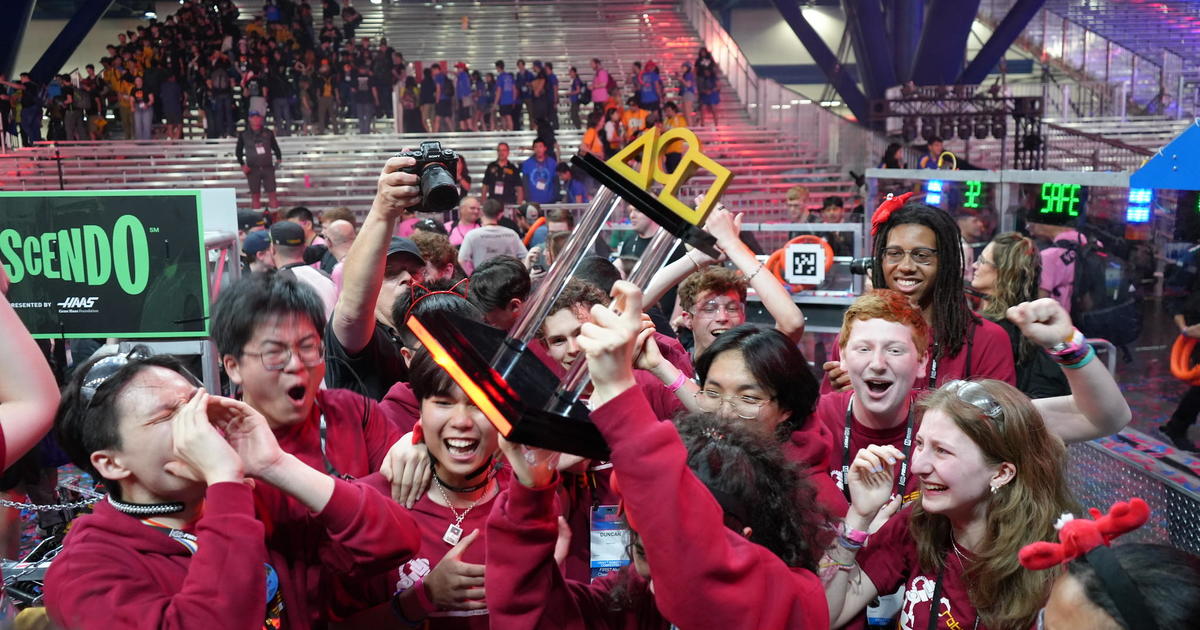Can Robot Pets Comfort You As Well As Real Ones?
By Jacqueline Howard
PHILADELPHIA (CNN) -- Your next Fido just might be a robot.
The toy company Hasbro's Joy for All brand launched a new life-like robotic dog on Monday, a companion pet pup to accompany the brand's companion pet cat already on the market. Both products are designed to bring companionship and comfort to aging adults.
The robotic cat is equipped with a soft fur that gently vibrates when it purrs, while the pup barks and cocks its head in your direction when you speak.
But Hasbro's adorable animatronics aren't the only pet robots on the market. The company Hansa Creations has created a collection of interactive cats and dogs of various breeds, for instance.
Mantua-Based Artist Makes Colorful Statement Against Eminent Domain
And Paro, the cuddly seal robot developed by Japan's National institute of Advanced Industrial Science and Technology, is used as an interactive therapeutic tool in hospitals and senior living facilities across the United States. Paro soared to fame after being featured in Aziz Ansari's Netflix series "Master of None."
Scientists have long known that owning a pet can offer a variety of health benefits, from lowering blood pressure, cholesterol levels and feelings of loneliness, to boosting opportunities to exercise and socialize.
Yet, as robot companions aim to be man's next best friend -- which seems to be somewhat already happening in Japan -- could they offer some of the same health benefits as our real animal best friends? For seniors and children, they just might, according to a few small studies, but more research is needed.
The benefits for grandma
A series of small studies have explored how bots might benefit seniors.
Researchers at the University of Auckland in New Zealand discovered that a robot companion -- such as the seal Paro -- can offer benefits to senior adults similar to that of a living animal, according to a small study published in the Journal of Post-Acute and Long-Term Care Medicine in 2013.
For the study, 40 residents at a retirement home in Auckland, New Zealand, were separated into two groups of 20. One group was assigned to interact with the seal robot Paro for two weekday afternoons for 12 weeks. Meanwhile, the other group was assigned to go on trips around the city and participate in activities, such as arts and crafts or bingo.
Before and after the 12-week period, participants in both groups completed tests intended to measure their loneliness, depression and quality of life.
After comparing how each group scored on the tests before and after the 12-week period, the researchers found that loneliness scores decreased in the Paro group, but increased in the control group. The residents also talked to each other more during the Paro sessions than the activity sessions.
Additionally, at the retirement home, an activities coordinator frequently brought her Jack Russell terrier to the facilities to interact with the residents. The researchers noticed that the residents touched and interacted with Paro more than they touched the Jack Russell terrier.
"Often residents were unable to talk to or touch the dog because the dog could choose who it interacted with, whereas the robot could be put on the lap of all residents and would respond to them. This research also found that Paro was able to impact the social environment," the researchers wrote in the study. They also noted that they have no conflicts of interest related to the research.
Similarly, a 2008 study published in the same journal found that interactive robotic dogs were effective in reducing feelings of loneliness among the senior residents of a long-term care facility.
Residents who participated in the research showed high levels of attachment to both a living and robotic canine, according to the study.
"We were told by some of the people in nursing homes that they preferred robotic pets because they would not have to worry about them if they had to be admitted to the hospital or that they couldn't take care of a living pet," said Dr. William Banks, professor in the division of gerontology and geriatric medicine at the University of Washington and a co-author of the 2008 study.
"It showed the extent to which loneliness occurs in nursing homes [and] how many people there want and enjoy pets," he said. "I was surprised to the extent that it improved loneliness and to the extent that attachment occurred."
An aging population
Ted Fischer, vice president of business development at Hasbro, is convinced that high-tech pooches and cats can help battle the feelings of loneliness and isolation that some older adults face, which may become more prevalent as the world's senior population grows, he said.
Adults 65 and older currently represent 8.5% of the global population, but that percentage is projected to jump to nearly 17% by 2050, according to the National Institutes of Health.
"We really did our research and focused on that demographic when a number of years ago we had a few products -- a line called FurReal Friends -- that were intended for 4- to 8-year-old girls.
Grocery Store Owner Gets Prison Term For Food Stamp Scheme
The reviews we were getting were from moms, but they were buying them for an aging loved one and writing about the impact and joy it was bringing to these folks," Fischer said.
"We leaned into that and went out into the senior community to understand what is it about this that might be meaningful," he said about the robotic pets. "What I can see from some of the experiences from folks who've had companion pets is there's this sort of trust and emotional connection and engagement."
Some experts have explored whether similar results could be found in children.
How kids respond to robotic Rover
It turns out that robot pets show both limitations and some promise when it comes to being a beneficial companion for children, according to a 2009 study published in the Journal of Social Issues (PDF).
For the small study, researchers from Purdue University and the University of Washington observed and interviewed 72 children as they played with a Sony robotic dog toy, called Aibo, and two friendly Australian shepherds. The children were ages 7 to 15.
When asked the same questions about the living dog and the robotic dog, the researchers discovered that the children in the study viewed the robot as a social companion in a similar way to which they viewed the living dogs.
During a focus group interview, one fourth-grader told the researchers, "I could take Aibo to school and with me everywhere."
However, the robot still seemed to have more "limited" interactive capabilities than a real four-legged friend, according to the children's responses.
"The findings suggest caution in assuming that a robot pet or robot-assisted therapy can be an effective substitute for a living companion animal or animal assisted therapy. Social policies that might make robot pets more accessible and affordable -- such as, to socially isolated seniors living in institutional settings -- should be weighed against policies making living animals more accessible and affordable," the researchers wrote in the study.
Indeed, humans should consider how robot companions might impact our relationships with animals, said Jean-Loup Rault, senior research fellow and animal welfare expert at the University of Melbourne in Australia. There are about 218 million pets living in the United States, not counting pet fish.
"Pets are good for us, but are we good for pets? Would robotic pets actually be a more ethical choice, respectful of the sentience of other living beings, in situations when the social and physical needs of the pet are not going to be fully met?" Rault said. "More science is needed to understand how much robotic pets simulate the effects we derived from relationship with live pets."
The-CNN-Wire ™ & © 2016 Cable News Network, Inc., a Time Warner Company. All rights reserved.



